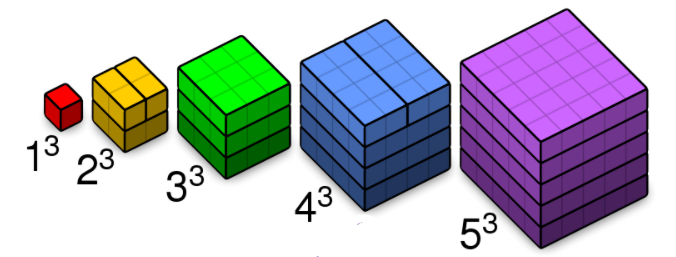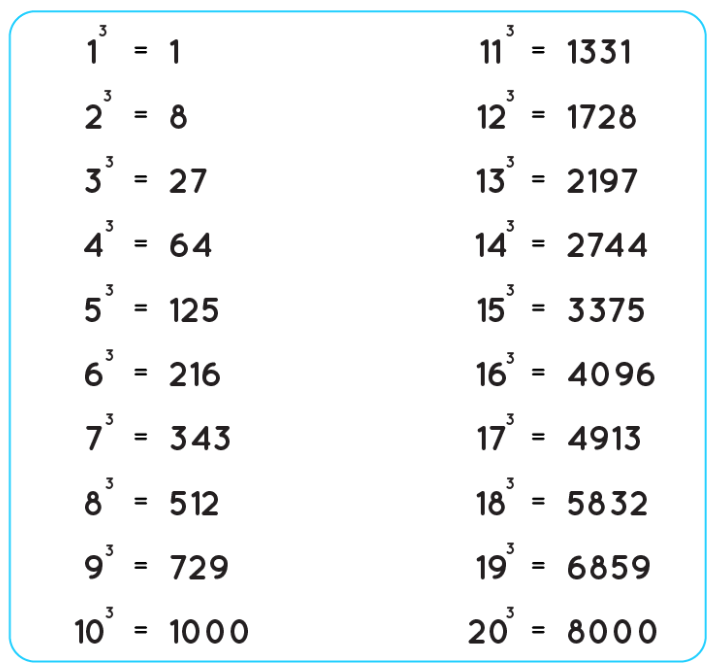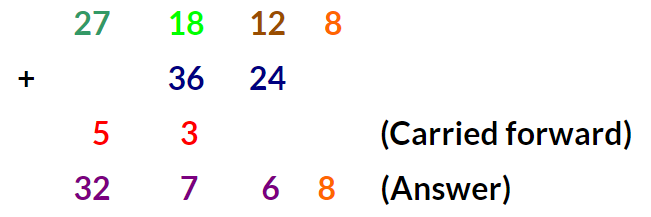CUBES AND CUBE ROOTS for Class 8 MATHS
INTRODUCTION
Baccho, aapne apne previous chapter m square and square roots k baare m pdha tha. Humne seekha tha ki square unit basically kisi figure k area k lie use kia jaata hai. Jab ek number khud se multiply hota hai to vo uska square kehlaata hai. But what if agar hum ek number ko usi se teen baari multiply kre (a×a×a)? Baccho, ise cube kehte hai. Jis tarah squares area nikaalne m use aate hai vaise hi cubes volume nikaalne m kaam ate hai. Kisi ek 3D figure m kitni space hoti hai use volume kehte hai. Suppose aapke paas ek cuboidal container hai jiski aapko height, length aur breadth given hai. Jab aap iss container ka volume nikaalenge to aapko answer unit cube (unit3) m milega. Kyunki yaha p volume nikaalne k lie we multiply 3 measurements, islie we call it as unit cube This is one example of application of cubes. In this chapter we will learn about cubes and cube roots and different methods to find them. We will also learn about quick vedic math tricks to help us build our concepts. So let's begin!
CUBE
Baccho jab hum ek number ko usi number se do aur baari multiply krte hai jisse humare paas teen numbers ka product aata hai, use hum uss number ka cube kehte hai. When we multiply a number two times by itself, we get the product of 3 numbers, all three numbers being the same. The resultant number(product) is known as the cube of the original number. We call it a cube because it is used to represent the volume of a cube. Hum ye bhi keh skte hai ki jab ek number ko 3 ki power (exponent) p raise kiya jaata hai to resultant ko uss number ka cube kaha jaata hai. For example, the cube of 3 is 27. That means 3×3×3=27, and it can be written as 33. Similarly, the cube of 4 is 64, and the cube of 5 is 125, and so on. Bachho, cube k concept se related ek interesting example hai Hardy-Ramanujan Number.
Hardy Ramanujan was a mathematical genius who pointed out that the number 1729 is very unique because it is the smallest number that can be expressed as a sum of two cubes in two different ways:

Look at the following list of numbers and their cubes. Memorizing cubes of these numbers will help you a lot in your further classes.

INTERESTING PATTERNS
Let's observe some patterns related numbers and their cubes.
1.Adding Consecutive Odd Numbers
We can see from the above pattern, if we need to find the n3, n consecutive odd numbers will be needed, such that their sum is equal to n3.
This pattern holds true for all natural numbers.
Also, if we need to find n3 then we should add n consecutive natural numbers starting from odd natural number.
2.Cubes and their prime factors
In this pattern we'll observe that in the prime factorization of any number, if each prime factor appears three times, then the number is a perfect cube.
Let's look at the steps to find the Perfect Cube
The perfect cube of a number can be checked by following the steps given below:
Step 1: Prime factorize the given number starting from the smallest prime number (2).
Step 2: Once the prime factorization is done, club every three same factors together.
Step 3: Repeat the step for all the sets of the group of the same three factors. If there are any factors that are left behind and do not fit into a group of three same factors, then the given number is not a perfect cube. Otherwise, the given number is a perfect cube.
Let us understand this with an example.

Here are a few more examples following the same pattern:
Example 1
Is 243 a perfect cube?
Prime Factorization of 243
243=3×3×3×3×3
Since, 3 is not in a triplet
∴243 is not perfect cube.
SMALLEST MULTIPLE THAT IS A PERFECT CUBE
Baccho, iss section m hum seekhenge ki hum smallest number kaise nikaal skte hai jisko kisi number se multiply/divide krke vo number perfect cube bnjaaye. It is related to the previous topic about prime factorization. As we have seen that the group of three prime factors makes a number perfect cube, so to make a number perfect cube we need to multiply it with the smallest multiple of that number. Let's understand this with a situational example.
Baccho suppose ki aapke paas ek clay ka cuboid hai jiski dimensions hai : Length = 15 cm,Breadth = 30 cm,Height = 15 cm
Aapko ye pta lgana hai ki aise aur kitne cuboids ko use krke aap ek perfect cube bna skte hai. Try to relate this with prime factorization pattern that we studied above. That pattern allows us to know that by multiplying what number we can get a triplet and a perfect cube.
Volume of cuboid is 15×30×15=3×5×2×3×5×3×5
=2×3×3×3×5×5×5
Since there is only one 2 in the prime factorization. So we need 2×2, i.e.,4 to make
it a perfect cube. Therefore, we need 4 such cuboids to make a cube.
Example 2
Is 392 a perfect cube? If not, find the smallest natural number by which 392 must be multiplied so that the product is a perfect cube.
Factorization of 392=2×2×2×7×7
No, this is not a perfect cube.
After multiplying by 7 we can make it perfect cube
New number=392×7=2744.
Example 3
Is 53240 a perfect cube? If not, then by which smallest natural number should 53240 be divided so that the quotient is a perfect cube?
53240=2×2×2×5×11×11×11=23×113×5
Thus, 53240 is not a perfect cube.
If we divide it by 5 it will a perfect cube.
Example 4
Is 1188 a perfect cube? If not, by which smallest natural number should 1188 be divided so that the quotient is a perfect cube?
1188=11×3×3×3×2×2
Thus, 1188 is not a perfect cube.
If we divide it by 44(11×2×2) it will be a perfect cube.
Example 5
Is 68600 a perfect cube? If not, find the smallest number by which 68600 must be multiplied to get a perfect cube.
Factorization of 68600=2×2×2×5×5×7×7×7
No, it is not a perfect cube
After multiplying by 5 this number can be a perfect cube.
CUBE ROOT OF A CUBE
When we think about the words cube and root, the first picture that might come to our mind is a literal cube and the roots of a tree. Isn't it? Well, the idea is similar. Root means the primary source or origin. So, we just need to think "cube of which number should be taken to get the given number".
Baccho jaise humne previous chapter m squares k baare m pdha tha, humne ye bhi jaana tha ki har square ka inverse operation square root hota hai. Similarly, cube ka inverse operation cube root hota hai. Cube root vo number hota hai jise khud se do baari multiply krke hume ek cube number milta hai. In mathematics, the definition of cube root is written as, "Cube root is the number that needs to be multiplied three times to get the original number." Now, let us look at the cube root formula, where y is the cube root of x.
3√x=y
. The radical sign 3√ is used as a cube root symbol for any number with a small 3 written on the left of the sign. Another way to denote cube root is to write 13 as the exponent of a number like x13

The following table represents perfect cubes from 1−30 and their cube roots.

CUBE ROOTS THROUGH PRIME FACTORIZING
The cube root of a number can be determined by using the prime factorization method. In order to find the cube root of a number, start with the prime factorization of the given number. Then make triplets of the obtained factors. After that, count each triplet as one multiply the factors to get the answer. If there is any factor left that doesn't form a triplet, that means the given number is not a perfect cube.
For example, let us see how we find the cube root of 15625.

Example 6
Find the cube root of 8000.
Prime factorisation of 8000 is 2×2×2×2×2×2×5×5×5
So, 3√8000=2×2×5=20
Example 7
Find the cube root of 13824 by prime factorization method.
Prime Factorization of 13824=2×2×2×2×2×2×2×2×2×3×3×3=23×23×23×33
Therefore, 3√13824=2×2×2×3=24
CUBE ROOT OF A CUBE NUMBER USING ESTIMATION
Baccho humne previous chapter m square roots estimate krna seekha tha. Now we'll see how we can estimate cube roots. Estimation means kisi cheez ko closely guess krna. If a cube number is given we can find out its cube root using the following steps:
Example 8
Find the cube root of 17576 through estimation.
17576
203<17576<303
Unit digit of 17576 is 6
∴Unit digit of 3√17576 will be 6
⇒3√17576=26
TRICKS TO CALCULATE CUBE AND CUBE ROOTS
Baccho, cubes and cube roots calculate krne k lie hume repeated multiplication aur prime factorization jaise methods ko use krna pdhta hai jo ki lengthy hote hai especially for bigger numbers. Iss section m hum kuch quick tricks and methods seekhenge to calculate cubes and cube roots. So let's begin!
Let's learn to find cube roots of bigger numbers like 39304 through a shortcut method involving four steps:
STEP 1:
To find the unit place of the cube root always remember the following points:
Therefore, the unit digit will be 4.
STEP 2:
Now, strike off the last 3 digits of the given number.
39304
STEP 3:
Now, find the nearest cube of the first 2 digit from the left, i.e., 39.
The nearest cube is 27.
STEP 4:
Now, 3 is the cube root of 27.
Therefore, the ten’s place digit will be 3.
So, the answer will be 34.
ANOTHER EXAMPLE
Let us now find the cube root of 238328 with the same method
238328
The nearest cube is 216.
Baccho, now let's learn to find cubes using vedic maths tricks:
Type 1: Numbers starting with 1
(16)31. We consider 1 as 1st term and 6 as 2nd term, we will write the given term as it is i.e.

2. Square the 2nd term i.e. 62=36 and also cube the 2nd term i.e.=63=216 and write the values in 1st row i.e.

3. In 2nd row double the 2 middle terms (. i.e. is 2nd term and 3rd term) & write just below 2nd & 3rd term.

4. Add them vertically in column. carry forward the 10th places digit to next column

∴163=4096
Type 4: Numbers having different digit
(32)3
1. We consider 3 as 1st term and 2 as 2nd term, Cube the 1st term and 2nd term i.e. (3)3=27 and (2)3=8

2. Square the 1st term i.e. 32=9 then multiply by 2nd term i.e.9×2=18

3. Square the 2nd term i.e. 22=4 then multiply by 1st term i.e.4×3=12

4. In 2nd row double the 2 middle terms (. i.e. is 2nd term and 3rd term) & write just below 2nd & 3rd term.

5. Add them vertically in column. carry forward the 10th places digit to next column

∴(32)3=32,768
Let's Summarize
1. Numbers like 1729,4104,13832, are known as Hardy – Ramanujan Numbers. They can be expressed as sum of two cubes in two different ways.
2. Numbers obtained when a number is multiplied by itself three times are known as cube numbers.
For example 1,8,27,... etc.
3. If in the prime factorization of any number each factor appears three times, then the number is a
perfect cube.
4. The symbol 3 denotes cube root.
For example 3√27=3.
Let's Revise
For example:
3+5=8=23
7+9+11=27=33
Consider, the number 216. By prime factorization,
216=2×2×2×3×3×3=23×33=63
Hence, 216 is a perfect cube.
For example, 216=2×2×2×3×3×3
Since 2 and 3 forms triplets, therefore, 3√216=2×3=6